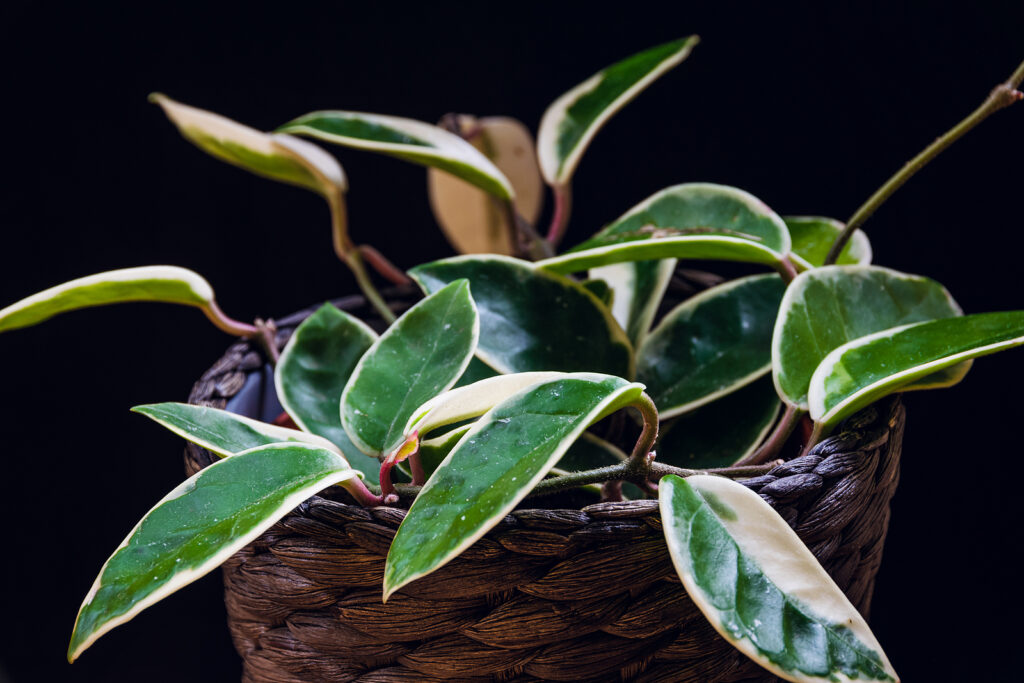Hoya is a shrubby or climbing tropical plant with leathery green leaves that appear in pairs along a flexible stem. Clusters of fragrant, star-shaped flowers are borne above pairs of leaves. Vines usually reach 3 feet (1m) long.
Both the leaves and flowers of Hoya have a waxy appearance. The glazed look of the star-shaped white blooms gives the plant its common names, porcelain flower, and wax plant.
Hoya has been a houseplant favorite for many years. It is typically trained on a trellis or up strings. Hoya can easily be trained to a wire hoop, topiary, or grown in a hanging basket. Hoya produces clusters of small white, honey-scented flowers that look like porcelain. The flowers dangle from the long vining stem.
Hoya is grown as a houseplant in all but tropical regions. Where winter temperatures never drop below 50°F (10°C), wax plant can be grown outdoors.
Hoya is a genus of more than 200 species of evergreen perennials and climbers. Hoya carnosa is most commonly grown as a houseplant. The Hoya genus is native to stream margins and rainforests in tropical Asia, Australia, and the Pacific Islands.
Get to know Hoya
- Plant type: Tropical perennial
- Growing Zones and range: Zones 12-15
- Hardiness: Tender; best not below 50°F (10°C)
- Optimal growing temperature: day 70°F (21°C), night 55° to 60°F (13°-16°C)
- Height and width: 24 to 36 inches (60-90cm) tall and wide as a housplant; in tropical regions 15 to 25 feet (5-8m) tall depending on the variety
- Foliage: Long trailing stems with waxy, leathery succulent silvery green leaves to 3 inches (7.5cm) long; leaf shapes and colors vary
- Flowers: Clusters of small, star-shaped; ½-inch across white flowers with reddish-purple centers; flowers have a honeylike scent; flowers dangle from stems. Flowers are produced repeatedly on leafless spurs that grow from the main stem.
- Bloom time: Summer
- Uses: Grown as a houseplant in most regions; best on a trellis or in a hanging basket; can be grown in outdoor container plant in warm-winter regions
- Common name: Wax plant, porcelain flower
- Botanical name: Hoya
- Family: Asclepiadaceae
- Origin: Asia, Australia, Pacific Islands

Where to plant Hoya
- Light indoors: Grow Hoya in strong reflected light, not direct sunlight.
- Light outdoors: Full sun with some shade depending on the variety; direct morning sun encourages flowering; avoid mid-day sun.
- Soil indoors: Plant Hoya in indoor potting soil. Grow Hoya in a peat moss-based mix in a pot or in a hanging basket lined with sphagnum moss.
- Soil outdoors: Humus-rich, well-drained soil.
How to water and feed Hoya
- Allow the soil surface to dry out between waterings; in winter water slightly less; higher humidity encourages flowering. Hoya needs slightly higher than average humidity; mist plants daily.
- From spring through fall, let the soil dry between waterings. In winter reduce water drastically, just enough to prevent shriveling. Do not use cold water.
- Fertilize three times in summer with a 10-30-10 liquid fertilizer; do not fertilize in winter during the rest period.
Hoya care
- Provide potted plants with a trellis or wire hoop; wind the stems counterclockwise around the support
- Mature plants prefer to be potbound. Hoya blooms best with potbound. Repot young plants each year after the rest period.
- Hoya must be 3 feet (90cm) long to bloom, so avoid pruning—pruning may remove the stubby flowering spurs
- Carefully remove faded blooms leaving woody spur extending from leaf axil intact; from these spurs, new blooms will emerge.
- Let plant rest from fall through winter; it becomes semi-dormant. Set in a cool spot, 50°F (10°C); give just enough water to keep soil from drying out; withhold fertilizer.
Growing Hoya as a houseplant
- Hoya must have direct light, average room temperature, and low humidity. Does best in average warm conditions; avoid cold drafts.
- the soil should be kept moderately dry; soggy soil can cause root rot.
- Fertilizer should be applied occasionally during sprig and summer; excess fertilizer can cause the flower buds to drop.
Hoya pests and diseases
- Hoya can be attacked by aphids, mealybugs, mites, root rot, and scale.
Hoya propagation
- Propagate by layering or stem cuttings.
- Take stem cuttings in spring of the previous year’s growth.
- Hoya can be propagated by layering.
Hoya varieties to grow
- Hoya australis. Grows 12 to 20 feet in tropical regions; has greenish-white flowers with red bases and white crowns.
- H. bella, miniature wax plant, grow to 1 foot (30cm) high and has leaves that are dull green, oval to lance-shaped; flowers are ½ inch across; best grown in a basket; white flowers with crimson centers.
- H. carnosa, wax plant, honey plant. Ovate, rigid, fleshy leaves to 3 inches long, smooth dark green; bears dense umbels of pinkish-white flowers with red crowns; the leaves of one cultivar twist and curl, and thus the plant is called Hindu rope plant. Hoya carnosa is commonly grown; cultivars below:
- ‘Variegata’ has cream-edged leaves.
- ‘Exotica’ has leaves with yellow centers and green margins.
- ‘Krimson Princess’ has reddish young leaves.
- ‘Krimson Queen’ has reddish-green leaves with ivory margins.
- ‘Tricolor’ has leaves that are copper and salmon-rose when young and green with ivory margins when mature.
- H. imperialis. Strong-growing, twining climbet has purple blooms with ivory crowns.
- H. multiflora has pale yellow flowers



